Key Scottish Environment Statistics 2016
Reference document offering information on a wide range of environmental topics, covering key datasets.
This document is part of a collection
Air Quality
Background
Air quality can be affected by the emission of pollutants into the atmosphere from a wide range of sources, and has implications for both human health [43] and the natural environment. The Air Quality Strategy [44] ( AQS) has introduced objectives that aim to improve air quality by reducing concentrations of several different pollutants.
Air Quality Management Areas
Local authorities with
Air Quality Management Areas as at 10 October 2016 [45]

While the Air Quality Strategy focusses on improving air quality at a national level, localised areas of poor air quality may remain. To address this, the Local Air Quality Management ( LAQM) system was established.
Under the LAQM system, all local authorities are required to regularly review air quality in their areas against several objectives for pollutants of particular concern for human health. If this work shows that any objective is not being achieved, the authority concerned must declare an Air Quality Management Area ( AQMA) and produce an action plan outlining how it intends to tackle the issues identified.
As at 10 October 2016, there are 36 AQMAs in Scotland. Eight of these have been declared solely for particulate matter ( PM 10) and a further 11 for both PM 10 and nitrogen dioxide ( NO 2). Sixteen of the remaining AQMAs are for NO 2 only and one is for sulphur dioxide ( SO 2). All except the SO 2 AQMA have been declared on the basis of emissions from transport sources.
Targets and Indicators
| Pollutant | AQS Objective | Year to be met | |
| Nitrogen Dioxide ( NO 2) | 1 hour mean of 200 µg/m 3, not to be exceeded more than 18 times a year | 2005 | |
| Annual mean of 40 µg/m 3 | |||
| Ground level ozone | 8-hour running mean of 100 µg/m 3, not to be exceeded more than 10 days a year | 2005 | |
| Particulate matter ( PM 10) | Stage 2 | 24 hour mean of 50 µg/m 3, not to be exceeded more than 7 times a year | 2010 |
| Annual mean of 18 µg/m 3 | |||
| Sulphur dioxide ( SO 2) | |
1 hour mean of 350 µg/m 3, not to be exceeded more than 24 times a year | 2004 |
| 24 hour mean of 125 µg/m 3, not to be exceeded more than 3 times a year | |||
| 15 minute mean of 266 µg/m 3, not to be exceeded more than 35 times a year | 2005 |
Emissions of Air Pollutants: 1990-2014 R
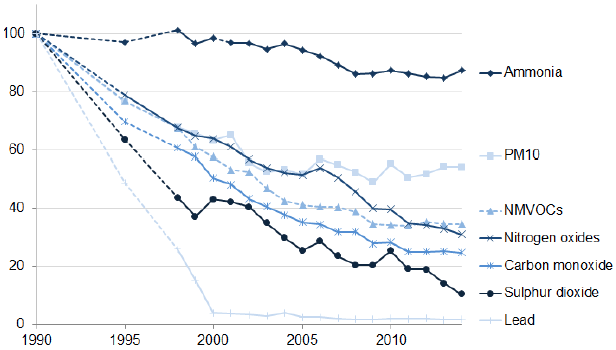
Index of air pollutant emissions (1990=100)
Why this measure is important
Air pollutants can negatively affect human and ecosystem health, with some pollutants such as PM 10 [46] being of particular concern to human health.
Background
Ricardo- AEA and Aether are contracted to provide estimates of air pollution emissions. These are published on the National Atmospheric Emissions Inventory.
Trend
Over the long term there have been reductions in emissions for all the pollutants in the inventory. Between 1990 and 2014, there have been decreases of 13% for ammonia, 46% per cent for PM 10, 65% for NMVOCs, 69% for nitrogen oxides ( NOx), 75% for carbon monoxide, 90% for sulphur dioxide and 98% for lead.
Factors affecting trend
Ammonia emissions have reduced through a combination of decreasing animal numbers and a decline in fertiliser use. Sulphur dioxide emissions fell following the move to gas fired power stations, the introduction of flue gas desulphurisation to coal-fired power stations and the closure of Cockenzie power station in 2013. Reductions in emissions of NOx and carbon monoxide are related to the need for new petrol cars to have 3 way catalysts installed and more recently the introduction of "Euro standards" for new cars. The decline in NOx emissions since 2007 is also linked to the power sector, as Boosted Over-Fire Air abatement systems were fitted which reduces NOx emissions formed during coal combustion. Reductions in NMVOCs are mainly the result of minimising fugitive emissions from sources such as oil loading and unloading operations. Historic reductions in lead emissions are due to the removal of lead in petrol.
Source: National Atmospheric Emissions Inventory
Metadata
Emissions of Sulphur Dioxide and Nitrogen Oxides from Large Combustion Plants: 1996-2015 [47]
Annual Large Combustion Plant emissions (thousand tonnes)
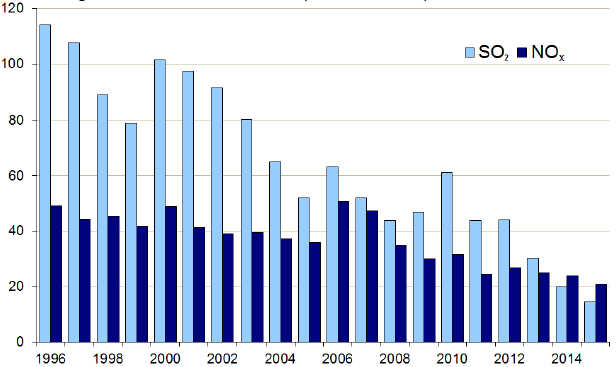
Why this measure is important
Sulphur dioxide ( SO 2) and oxides of nitrogen ( NOx) affect human health through respiratory damage, and ecosystem health through acidification. Oxides of sulphur, including SO 2, and NOx are released into the atmosphere through the combustion of fossil fuels.
Background
Data are obtained from the Large Combustion Plants Directive [48] ( LCPD) report, which is compiled for the United Kingdom LCPD submission to the European Commission.
Trend
In 2015, SO 2 emissions from large combustion plants decreased by 27% compared with 2014 and NOx emissions fell by 13% over the same period, mainly due to lower emissions from Longannet power station. Overall, SO 2 emissions from large combustion plants decreased by 87% between 1996 and 2015 and NOx emissions decreased by 58%. The 2015 SO 2 and NOx emissions are the lowest on record.
Factors affecting trend
Previous rises in emissions (for example, in 2006 and 2010) coincided with periods of cold weather that led to increased emissions from the electricity supply sector. This was in part due to increased electricity production at Longannet and the increased use of domestic coal that has a higher sulphur content. Trends in emissions from Large Combustion Plants can also be affected by the relative prices of coal and gas. The large decrease in SO 2 emissions can be partly attributed to the closure of Cockenzie power station in March 2013.
Source: Scottish Environment Protection Agency
Metadata
Particulate ( PM 10) Concentrations: 1997-2015 [49,50,51]
Annual mean concentration (µg/m 3)
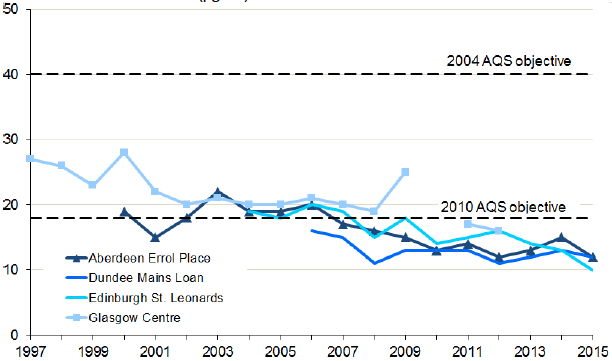
Why this measure is important
Particulate pollution can harm the human respiratory and cardiovascular systems, and is linked to asthma and mortality. Smaller particles are the most damaging as they can enter the bloodstream through the lungs. Current targets focus on particles less than 10µm in diameter ( PM 10), the greatest source of which is combustion. Between 1990 and 2014, Scottish emissions of PM 10 fell by 46% [52] .
Background
Data are obtained from automatic air quality monitoring sites, which measure the concentrations of a range of pollutants at various sites across Scotland.
Trend
The Stage 2 annual mean objective was not met at 4 of 64 automatic monitoring sites with a data capture rate of greater than 75% in Scotland in 2015 [53] , compared to 10 of 58 sites in 2014. Three of these sites also failed to meet the Scottish daily mean objective in addition to one other Aberdeen site. Edinburgh Salamander Street has not met the stage two Scottish annual mean objective since 2010. [54]
Factors affecting trend
Changes in PM 10 concentrations depend on the levels of emissions from several different sources including domestic combustion and power generation. Recent reductions in PM 10 concentrations can be attributed to a reduction in the emissions from power generation, largely due to a switch from coal-fired energy generation to gas, which produces negligible PM 10 emissions.
Source: Scottish Air Quality Database
Metadata
Nitrogen Dioxide Concentrations: 1992-2015 [55,56,57]
Annual mean concentrations (µg/m 3)
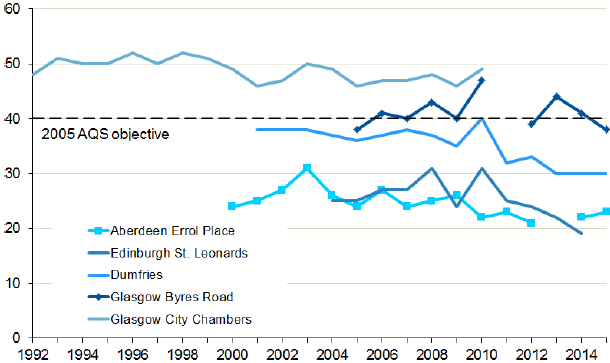
Why this measure is important
High concentrations of nitrogen dioxide ( NO 2) can affect human health, particularly by causing inflammation of the airways. Ecosystem health is also damaged by NO 2 through its contribution to acid deposition, eutrophication (accelerated plant growth in water bodies caused by excess nutrients) and promotion of the formation of ground level ozone.
Background
Data are obtained from automatic air quality monitoring sites, which measure the concentrations of a range of pollutants at various sites across Scotland.
Trend
In 2015, the annual mean objective was not met at 8 of the 70 automatic monitoring sites with a data capture rate of greater than 75% [58] in Scotland, compared to 10 of 68 sites in 2014. Those sites recording the highest annual mean concentrations were found next to busy roads, such as Glasgow Kerbside and Edinburgh St John's Road [59] . The hourly mean objective was met at all automatic monitoring sites in Scotland, apart from Edinburgh St John's Road.
Factors affecting trend
The main sources of nitrogen oxides (that are not produced naturally) are road transport, especially in urban areas, power generation and industry. Between 1990 and 2014, Scottish emissions of NOx are estimated to have decreased by 69%, due in part to the installation of catalytic converters in vehicles [60] .
Source: Scottish Air Quality Database
Metadata
Ground Level Ozone Concentrations: 1990-2015 [61,62]
Number of days exceeding 100µg/m 3 (maximum 8 hour running mean)
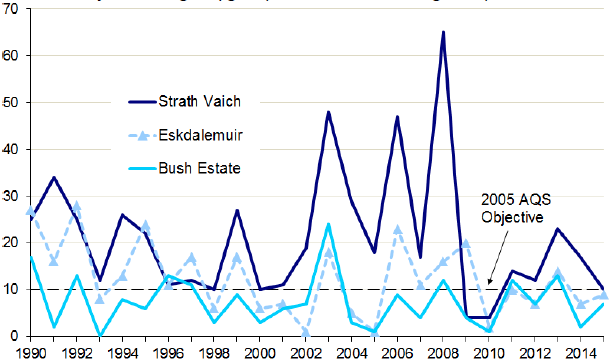
Why this measure is important
Ozone in the stratosphere forms a layer that protects the Earth against harmful ultra-violet radiation, but tropospheric (ground level) ozone is a damaging oxidant. Exposure to high ozone concentrations can cause respiratory damage and can affect vegetation by damaging leaves and reducing yields.
Background
Data are obtained from automatic air quality monitoring sites, which measure the concentrations of a range of pollutants at various sites across Scotland.
Trend
In 2015, the AQS objective was met at all 11 sites with a data capture greater than 75% [63] , compared to 8 of 9 sites in 2014. Annual average ozone concentrations fluctuate from year-to-year and, as such, it is difficult to say if there is any overall trend.
Factors affecting trend
Ozone is formed from other pollutants that may be blown over from Europe. The most important man-made precursors are nitrogen oxides and volatile organic compounds produced by road transport, industrial processes and solvent use. Ozone concentrations also tend to be lower in urban areas where it is converted to nitrogen dioxide by reacting with nitrogen oxides.
Source: Scottish Air Quality Database
Metadata
Sensitive Habitats Exceeding Critical Loads for Acidification and Eutrophication: 1995-1997 to 2011-2013 [64,65]
Percentage exceedance
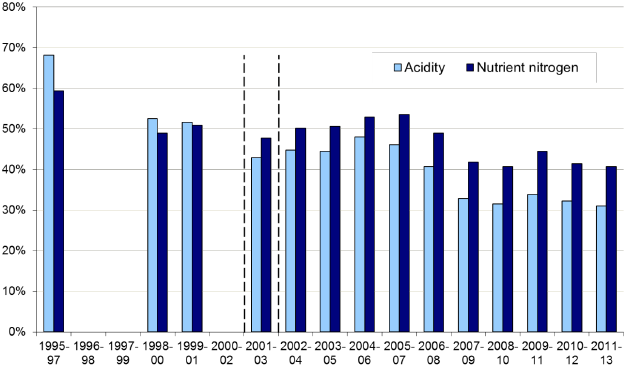
Why this measure is important
Critical loads are thresholds above which the deposition of pollutants causing acidification (sulphur dioxide, nitrogen oxides and ammonia) and eutrophication (nitrogen oxides and ammonia) cause significant harm to the environment. Around 60% of Scotland's land area contains habitats sensitive to acid deposition and 55% to eutrophication, with much of the area sensitive to both.
Background
Critical loads for acidity and nutrient nitrogen are calculated using internationally agreed methods. These are then compared with deposition values to calculate critical load exceedances and identify habitat areas at risk from the adverse impacts from acidification and eutrophication.
Trend
The area of sensitive habitats in Scotland exceeding critical loads for acidification fell from 68% in 1995-97 to 31% in 2011-13. Over the same time period, nutrient nitrogen exceedances fell from 59% to 41% [67] .
Factors affecting trend
Changes in the area of sensitive habitats exceeding critical loads largely depend on changing emissions of pollutants; for instance, the reduction in acidity exceedance has been largely driven by a reduction in sulphur emissions. Changes were also made to the methodology for calculating depositions in 2001-03 and 2002-04, which means that depositions for earlier years may be underestimated.
Contact
There is a problem
Thanks for your feedback